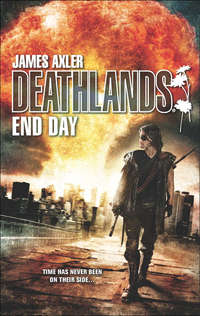
Полная версия
Breakthrough
Using a battered teaspoon, he laid a heaping dose of powder on every outstretched palm. Though some people licked it, most of them snorted it. The powerful drug took hold quickly, with alarming effect. It made eyes bug out and sweaty faces grimace spastically. To quench their suddenly raging thirsts, the revelers guzzled more free joy juice, and they all fell into a slow-spinning, half-speed dance.
At a signal from Mike, the music abruptly stopped and the three whores climbed down from the roof with the boom box. They entered the bus and walked past Huth, heading straight for the pile of mattresses in the back.
“Come on, people,” Mike urged, gesturing toward the bus’s entrance. “The real fun is starting. Slip and slide. Slip…and…slide.”
As stoned as they were, most of the Byram ville folks didn’t fall for his spiel, but they were in no shape to try to stop the few who did. Four men between the ages of twenty and thirty, and a heavyset, thirtyish woman mounted the bus’s steps. As the woman passed Huth and turned down the aisle for the rear, she jerked her black sleeveless T-shirt over her head and tossed it aside. Her huge soft breasts swayed pendulously as she struggled with the zipper on the front of her dusty BDU pants.
“Hey, it’s okay if you don’t want to come with me now,” Mike assured the rest of the crowd. “I’ll be back by here in a week or two. Give you all some time to think it over. Maybe I’ll even bring back your friends for a visit. You can hear firsthand what you’re missing.”
With that, he climbed back in the bus, started it up and U-turned for the checkpoint. Huth took a seat up front, right behind the driver, as far away from the goings-on in the back as he could get.
After they had cleared the gate, Mike double-clutched and shifted the bus into high gear. “How about some driving music?” he said over his shoulder. He poked the boom box, which sat perched on the dash. The 1999 song started up again at top volume, canceling out the grunting, whimpering racket from the rear.
Big Mike, clearly feeling the effects of all the joy juice he’d drunk, threw back his head and falsetto-screeched along with the vocalist.
For his part, Huth was content to bob his head and tap out the now-familiar beat with the toe of his size-13 jogging shoe. He watched the flat, parched landscape roll past the grimy window, toothlessly grinning while tears streamed down his face.
Chapter Four
Dredda Otis Trask deepened the tint of her helmet visor to shield her eyes against Slake City’s blinding, panoramic glare. From the history of her own Earth, she knew that there had once been a vast body of water in this place, the last remnant of an ancient inland sea. In Shadow World’s reality, on a late January day more than a century past, Great Salt Lake had been vaporized by a multiwarhead nuclear strike. And a fraction of an instant later, the sands of the exposed lake bed and the shattered metropolis of Salt Lake City were melted together, fused into a boiling, hundred-square-mile sea of thermoglass. As the infernal heat was sucked up into the atmosphere, towering waves of glass solidified in a nightmare snapshot, their peaks capped with a foam of rusting, fire-blackened litter. Massive, shock-blast-tossed fragments—skyscraper I-beams, sections of railroad track and metal utility poles—stuck up from the wave troughs like the masts of a drowned navy.
It was a place long dead, but it was neither silent nor still.
Between howling gusts of wind, the external microphones of Dredda’s battlesuit picked up what sounded like the scattered, desperate cries of abandoned infants. There were no lost babies out there. The phenomenon had to do with the nukeglass’s structural weaknesses, which were caused by mineral impurities, and by the pulverized debris and air bubbles it contained. Extreme changes in day-night temperatures caused hairline cracks to appear in the matrix, and as the splits spread and ran, they made the shrill, disturbing sounds.
Occasionally, there were much louder noises. As the fine cracks branched out, they became networks of fissures that eventually crashed down the roofs of hidden hollow spots. Some of these collapsed air pockets were the size of amphitheaters.
Dredda focused her attention on a distant column of human figures moving away from her, over the gray-green surface. The group of freshly captured slaves walked a road that ended at Ground Zero, some eight miles away from Slake City. A pair of huge black vehicles dogged the rear of the file, herding the work crew replacements.
Building a road across the nukeglass that could support heavy vehicle traffic had been dangerous work. Even with side-scanning sonar to point out the larger crevasses and voids, sudden cave-ins were frequent and nearly always fatal to the natives. The broken chunks had razor sharp edges and often weighed hundreds of pounds. Trying to pull trapped slaves from the cave-ins had turned out to be wasted effort: the shifting sections of thermoglass either sliced them to rags, or chopped them into pieces.
In the week that it had taken to complete road construction, Dredda had sacrificed half of the Shadow World work force she had pressed into service. Most of the slaves were young men who had been mining their meager living from the dead city. They used crude hand tools to hack holes in the surface and crawled into the hollow places in search of undamaged, pre-Armageddon odds and ends, which they then traded. As a rule, these independent scroungers only worked the outer edges of the nukeglass, where the lingering radiation was the weakest. Even so, after a few years of digging, most had developed angry sores and large, visible tumors.
At Ground Zero, tissue destruction proceeded much more briskly. After a few days in that high-dose radioactive environment, weeping blisters appeared on unshielded hands, faces and feet. Based on the rad exposure alone, the working life span of a slave was no more than two weeks. Because of other dangers related to large-scale mining in thermoglass, actual survival time was half of that. From Dredda’s point of view, this wasn’t entirely a negative: there was no need to feed slaves who were only going to live a week.
Her own survival, and ultimately the conquest of Shadow World, depended on the exploitation of local energy sources. The recon satellite’s first mission, postlaunch, had been to pinpoint the nearest, hottest nuke zone, a place that could provide the suitable raw material for her reprocessing units. The energy reprocessors utilized strains of genetically engineered bacteria that feasted on irradiated inorganic matter and secreted useable nuclear fuel. Every critical component of Dredda’s invasion force, from gyroplanes to battlesuits, was powered by this recycled material.
The skirmish Dredda had planned for this day would easily gobble up one-third of the precious little fuel that had been harvested from Slake City so far, but she had no choice in the matter. To stabilize the energy stockpile in the short term, she had to expand her mining operation, and to do that, given the life expectancy of her workers, she needed a much larger labor pool.
Behind her, eight huge landships waited, their nuke turbines humming at idle. Gleaming black and windowless, with smooth, aerodynamic contours, the 6×6s were the core of her ground force, able to traverse at high speed the most difficult terrain thanks to their seven-foot-diameter wheels, each with its own independent drive train and suspension.
As Dredda turned for her flagship, its right front door rose up like the wing of a great bird. Sunlight washed over the high-backed copilot seat, over a ceiling tangled with exposed conduit, wiring harnesses and gray Kevlar pipe. A fine film of desert dust coated the gangway’s steps.
Sitting in the other cockpit’s other chair, behind the steering yoke, was Mero. Her pale blue eyes gleamed through her battlesuit’s transparent visor; her close-cropped blond curls were partially hidden by a red skullcap. Like all the officers of Dredda’s invasion force, Mero was the product of Level Four genetic engineering. The experimental procedure had made her face less round, and her chin more square and prominent. The look of supreme confidence in her eyes, an expression that four tours with the dreaded Population Control Service hadn’t dimmed, was now reinforced by additional bone structure and dense layers of muscle.
Dredda understood exactly what Mero was feeling at that moment. Excitement. Impatience. And an intense curiosity about the future. The two women, indeed all the Level Four females, shared a bond that went deeper than their rank or sex, or the war upon Shadow World they were about to wage. They were all sister changelings, birthed in the same stainless-steel womb, explorers of a new universe without, and an equally mysterious and promising one within.
This visceral connection, this transgenic sisterhood was something Dredda hadn’t expected to feel so deeply, and it caught her unprepared. As much as the sense of belonging pleased her, it also unsettled her. She had never experienced anything quite like it before. Not even with her own father.
Looking between the cockpit seats to the rear of the vehicle, Dredda checked the rest of her crew. The male troops were strapped cross chest into twelve shock-mounted jump seats set between I-beams along the walls of the cargo bay. From the uniformly smug expressions behind their visors, they no longer had any fear of the enemy. During the slave raids on Slake City scrounger camps, they had absorbed barrages of fire from a variety of primitive combustion-powered rifles, shotguns and pistols. Their battlesuits had deflected every projectile with ease. Their own battle gear, tribarreled laser rifles and phage-foam back tanks, was netted, rattle proofed and lashed down to the middle of the cargo deck.
When Dredda sat down in the copilot seat, it immediately adjusted itself, inflating and deflating to match the curves and overlapping plates of her battlesuit. The windshield in front of her was dead black. When the wing door hissed down and locked shut, the only available light came from the instrument panel. It bathed the wag’s interior in hellish red.
Dredda coupled her battlesuit to the dashboard umbilical and opaqued her visor. Immediately, the instrument lights and blacked-out windows vanished, as did the entire outer skin of the vehicle. Suddenly, Dredda was sitting alone, in the open air, five feet above the ground. Each crew member found him-or herself likewise isolated from the others and suspended in space. This illusion was produced by the hull’s optical scanning system, which filtered out unnecessary detail and projected a three-dimensional image of the external environment directly onto the interior surface of the helmet visors.
Keying her battlesuit com link to the driver, Dredda said, “Start the mission clock.”
Mero throttled up the turbines. As the hum grew louder, the chair in which Dredda sat began to move. It accelerated rapidly, until it was flying over the ground. To her right, the details of the Slake City massif stretched and blurred. G-force drove her deep into the contour seat, but there was no accompanying sensation of air pressure—it was the only flaw in the elaborate computer simulation. If she had really been strapped unprotected to a rocket-powered chair, the wind would have been a tangible, buffeting force against the front of her body.
Ahead, she could make out the lake-bed landing zone, and the six black gyroplanes on standby there. Dredda keyed the com link again and gave the order, “Airborne units proceed to the staging area.”
The VTO/L attack aircraft immediately lifted off and swung toward the mountains to the southwest, strung out in a quarter-mile skirmish line.
Dredda and her chair continued due west, rushing across the flat plane of pale dirt, leaving Slake City behind. The other wags ran on either side of her in loose, flying-V formation. Their speed over ground was 140 miles per hour. Dredda felt some vibration in the pit of her stomach and her feet, but it was disconnected from the images inside her visor, which moved only when she turned her head.
The formation slowed to make the turn south at old Iosepa Road. The undivided pavement had vanished long ago, but the roadbed was still there, covered by drifts of sand, salt and dust. It ran straight as a laser pulse for twenty miles.
As they approached the slight bend in the road where the predark hamlet of Iosepa had been, Dredda ordered the vehicles cloaked. This was accomplished by reducing the side-to-side distance between the wags to a few feet and then electrostatically charging the hulls, which redirected most of the dust cloud they were raising aft, and made it jet forward from under their front bumpers, creating a roiling, onrushing wall of dirt that preceded and entirely enveloped them.
Inside her visor, Dredda could see nothing but swirling beige.
Mero and the other sisters were driving blind at identical high speeds, maintaining tight formation over broken ground using battlesuit-sat link intel and helmet simulacra for steering. Dredda switched her visor screen to monitor what they were viewing.
Along the sides of the green-on-green field were a dozen inset windows with numbers rapidly scrolling up or down. There were complex nuke-turbine function and tank-temperature indicators. Other windows displayed the vehicle’s true course over ground, in latitude and longitude, and its true speed over ground. There were flashing proximity warnings about the vehicles on either side, in feet. The distance to the target was shown in yards, and falling rapidly. In the center of the screen were eight wag-shaped, lime-green blips in a sideways row. Beneath the shifting blips, a shades-of-green, satellite-generated contour map of the terrain unrolled wildly.
Only one of the blips on Mero’s screen ran inside a set of parallel lines—these boundaries indicated her vehicle’s computer-assigned course. The paired lines were constantly moving as the computer adjusted for the deflection of the irregular terrain, and driver error and deflection in the seven other vehicles. As Mero kept the blip within the course boundaries, her decision time was measured in fractions of a second. Allowable, real-world error before catastrophe was measured in inches.
Dredda switched screens again, calling up the biometric readouts of her wag squad. Her heart rate and Mero’s were holding steady at forty-five beats per minute; the men’s were four times that, and their blood pressures were spiking. She quickly scanned each trooper’s current video input. None of them was observing the driver’s screen; they were either beigedout or off-line, presumably staring at the red gloom of the cargo bay. Dredda tried to imagine how Mero’s screen would look to them.
Pure chaos.
An information and threat overload.
A helter-skelter fright ride, their lives in the hands of a gene-spliced maniac.
Dredda couldn’t see their eyes, but it amused her to think they were all shut tight.
The Level Four procedure that she and her officers had endured had changed more than their external physiques, their fat metabolism and resting heart rates. It had expanded and fine-tuned their biological systems to match the extreme limits of the battlesuit’s cyber-capabilities; something the male physiology, gene-doctored or not, could never achieve. Their increased numbers of neurons allowed them to intake and process information a hundred times faster than the men.
As Dredda understood the science, there were built-in bioengineering limits to each of the sexes, based on the amount of body space and chemistry devoted to their differing reproductive functions. In the case of the females, much more of their capacity—hormonally, metabolically, neurologically—was taken up by these duties. If the biochemical obligations of motherhood were removed, there was room for the system to change and grow. On the other hand, men’s reproductive functions took up very little of their bodies’ overall capacity, so removing it had no effect on potential growth. Evolutionarily speaking, the male of the species was already maxed out.
When Dredda uplinked her visor to the infrared image of the target compound, she saw human forms running. Now that the dust cloud was visible to them, the Shadow Worlders were taking up defensive positions inside the fenced perimeter. On their part, it had to be a precaution. They didn’t know what the approaching cloud meant, and they weren’t taking any chances. The important thing was, they weren’t abandoning the compound in droves. Because they controlled the high ground from well-positioned defensive hardsites, with lots of conventional weapons, they believed they were invulnerable. The function of the dust cloak was to maintain this illusion as long as possible—slaves were more profitable caught in large bunches.
Dredda panned back for a broader infrared view of the kill zone. The exhaust ports of the heavily armed gyroplanes registered as six bright spots sweeping around the western flank of Mount Deseret, closing on the compound from the north. It was time for the ground units to uncloak, and she snapped out the order.
As the wags burst through the face of the electrostatic dust cloud, the compound’s twelve-foot-high, wire perimeter fence appeared out of nothing, directly in front of them. Beyond it was the broad parking lot, and on the other side of it, the main complex that snuggled up against the foot of the mountain. The eight landships hit the fence at the same instant, flattening it and twisting it under their huge wheels. As they roared onto the parking lot, a fusillade of hostile fire zinged at them from all sides. The clatter of the gunshots and the ping-whine of bullets deflecting off her wag’s EM shield was so loud it forced Dredda to turn down the audio in her battlesuit.
When she activated the wag’s weapons pods, which were located on either side of the roof, two joysticks popped out of dashboard in front of her. As her gauntleted hands closed on the no-slip grips, a ring and crosshair sight appeared in the center of her helmet visor. Her targets, human-shaped figures in lime green, scattered to either side as the wag continued to rumble up the slope. Dredda flipped off the grip safeties with her thumbs.
Each of the joysticks operated its own cannon pod. As she moved her hands apart, the lone crosshair ring blurred, divided and became two. She simultaneously tracked a pair of men running in opposite directions. One was scrambling out of a foxhole hacked in the asphalt on her left; the other high-kicked to the right as he abandoned a sandbagged, burned-out hulk of a vehicle. When the computer target locks engaged, the sprinting figures turned red, and she jiggled the firing buttons.
Green lances of light stabbed through both runners. Neither completed another step.
Foxhole Man fell in four pieces, sliced cleanly through the chest and both arms above the elbow by a single burst of pure energy. His transected parts landed in a jumbled heap. The other man took the laser slash at waist height. The emerald light separated his torso from everything below his hips. It was a grievous mortal wound, but not immediately so. Though the man had been chopped in half, there was no blood—the laser sliced and cauterized at the same time. Rearing up from the pavement with undamaged arms, he seemed to recognize the severed legs under his chin as his own. His mouth opened wide in a scream that Dredda couldn’t hear. Frantically clawing, he tried to drag himself away.
Конец ознакомительного фрагмента.
Текст предоставлен ООО «ЛитРес».
Прочитайте эту книгу целиком, купив полную легальную версию на ЛитРес.
Безопасно оплатить книгу можно банковской картой Visa, MasterCard, Maestro, со счета мобильного телефона, с платежного терминала, в салоне МТС или Связной, через PayPal, WebMoney, Яндекс.Деньги, QIWI Кошелек, бонусными картами или другим удобным Вам способом.









